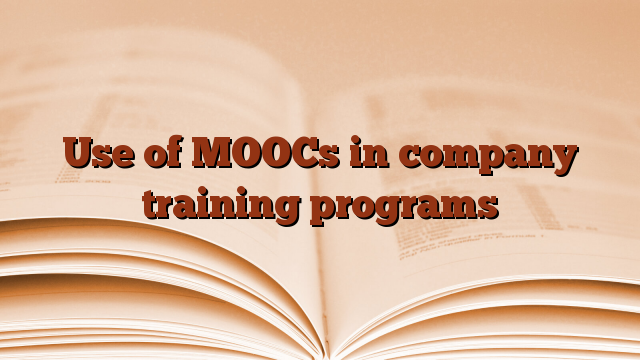When the MOOC mania first exploded, there was a general panic in higher education: would MOOCs make colleges and universities obsolete? Now that the dust has settled and stakeholders have been able to evaluate the new technology, the general consensus (at least for now) is no. MOOCs will not kill higher education, but they will have a major impact on how it is delivered. The same applies to in-company training. According to Brian D. Voss, VP and CIO at the University of Maryland, the MOOC revolution is not only technological, but also educational. Instructors across the board are being forced to reconsider the best methods of delivering content and assessing learning.
In a previous article we saw that the acronym MOOK used to describe many types of courses, some very similar to traditional courses and others being horses of a completely different colour. Companies also have several options for integrating MOOCs into their training programs. For example, will all training be delivered via a MOOC, or will the MOOC be used in conjunction with an instructor-led training (ILT) as part of a blended learning environment?
For training delivered entirely through a MOOC, one option is to use MOOCs that are already available. Many organizations offer pre-packaged MOOCs, and this is a very good option for workplace skills, professional development, and other parts of a training program that don’t require company-specific content. The Saylor Foundation offers a Workplace Skills Program that includes courses in computer skills, professional writing, and time and stress management. They are also developing several technical courses as part of a career development program and are expected to launch ‘Microsoft Excel for Beginners’, ‘Management and Information Processing’ and ‘Relational Database Applications’ in Summer 2013. ALISON is a MOOC provider specializing in workplace skills and professional development, offering courses in business and corporate skills, finance and economics literacy, digital literacy and IT, and personal development and soft skills. To use these courses as part of a training program, simply have your employees complete the courses online and then print the certificates as proof of completion – no additional training is required.
Another option is to create a MOOC from scratch. This is a good option for content areas where much of the material is already provided via e-learning or where generic courses have not been developed or are insufficient, e.g. B. Sales Training. Although almost three quarters of companies already have a Learning Management System (LMS) in place, many of these LMSs are not equipped to handle the volume of a MOOC. Luckily, there are several platforms that you can use to easily create your own MOOC. Instructure’s Canvas Network is an open source LMS used by many schools and institutions. It is easy to use for both administrators and students, there are many communication options and it is available on mobile devices. Here are some other platforms for creating your own MOOCs to consider: Desire2Learn, ProProfs Training Maker, P2PU, and Google Course Builder (still in beta testing). You can also bypass the LMS altogether and set up the course as a wiki.
For content areas that require more interaction and collaboration, organizations can integrate MOOCs and ILTs into a blended learning environment. This is the direction several community colleges and other educational institutions are taking to get the best of both worlds. While replacing ILT with a MOOC certainly benefits from the technological innovations, the real benefits of MOOCs are pedagogical in nature. Even institutions suspicious of MOOCs still bet on their most important pedagogical innovation: the flipped classroom.
In the flipped classroom model, students watch video lectures at home, then use class time to discuss material and work on projects. Instead of just being a space for knowledge transfer, the classroom becomes a collaborative environment for students and teachers to exchange ideas and solve problems together. Not only are students more actively engaged, their performance improves: Studies in higher education have shown that students in flipped classrooms perform better and experience less stress than the same students in traditional classrooms. This model can be applied to corporate and workplace training alike: employees could watch video lectures themselves and then use training time at the workplace to role-play, participate in hands-on training, practice their problem-solving skills, and participate in simulations.
Another MOOC element that can be easily incorporated into a training program is working on collaborative documents to build a knowledge base for employees. Many MOOCs have wikis that students are free to edit, encouraging sharing and collaboration. A wiki allows users to contribute their own knowledge and benefit from the knowledge of others, and changes are instantaneous rather than waiting for the system administrator to update the content.
MOOCs are evolving almost daily as more educators experiment with this new form of content delivery. As technology improves, the tools expand and the educational benefits become even greater and more prominent. By exploring and integrating the different MOOC options now, you can ensure your organization is well positioned to adopt new technologies and pedagogies in the future.
Thanks to Bryant Nielson | #MOOCs #company #training #programs

Leave a Reply